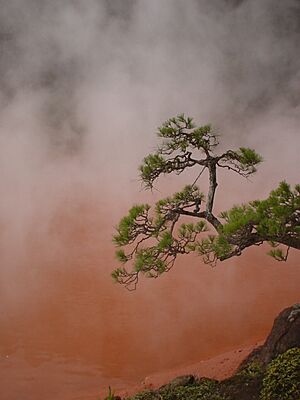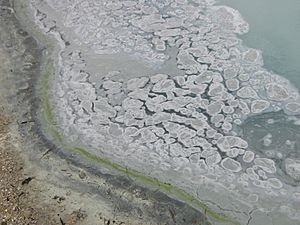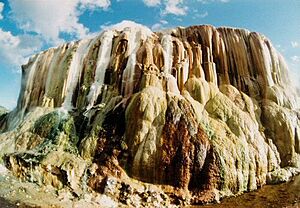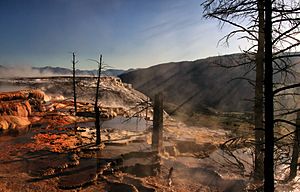Hot spring facts for kids

A hot spring is a special kind of spring where warm or hot water comes out of the Earth's crust. This water is heated naturally by geothermal energy, which is heat from deep inside our planet. You can find hot springs all over the world!
Contents
What is a Hot Spring?

There isn't just one perfect way to define a hot spring. But generally, it's a natural spring where the water is much warmer than the air or other nearby water.
Some people say a hot spring is:
- Any spring heated by the Earth.
- A spring with water hotter than 21.1 °C (70 °F).
- A spring with water hotter than the average human body temperature (around 37 °C (99 °F)).
Sometimes, you might hear about a "warm spring." This usually means the water is warm but not as hot as a typical hot spring. For example, the US NOAA says a warm spring has water between 20 and 50 °C (68 and 122 °F).
How Hot Springs Get Their Heat

The water in a hot spring gets its heat from deep inside the Earth. This is called geothermal heating. Imagine the Earth like a giant onion with many layers. The deeper you go, the hotter it gets! This increase in temperature with depth is known as the geothermal gradient.
When water from rain or snow seeps deep into the crust, it touches hot rocks. These rocks heat the water. Then, the heated water rises back to the surface, forming a hot spring. This is how hot springs are formed in areas without volcanoes.
Hot Springs in Volcanic Areas
In places with active volcanoes, like Yellowstone National Park, water can get super hot! It might even touch magma (molten rock) deep underground. When water gets this hot, it can start to boil or become "superheated."
- If the superheated water builds up a lot of steam pressure and shoots out of the ground like a fountain, it's called a geyser.
- If only steam comes out of the ground, it's called a fumarole.
- If the hot water mixes with clay and dirt, it creates a bubbling pool of mud called a mud pot.
Important Safety Note: Hot springs in volcanic areas are often at or near the boiling point of water. The water can be extremely hot and dangerous. People have been seriously burned or even killed by accidentally falling into or trying to enter these springs. Always stay on marked paths and obey all warning signs when visiting these areas.
Warm Springs and Their Uses
Sometimes, a warm spring forms when hot water from deep underground mixes with cooler cold springs closer to the surface. These can be found in volcanic areas or places without volcanoes.
One famous example of a non-volcanic warm spring is Warm Springs, Georgia. A former U.S. President, Franklin D. Roosevelt, often visited these springs for their therapeutic (healing) effects. He built a special house there called the Little White House.
Related pages
Images for kids
-
Grand Prismatic Spring and Midway Geyser Basin in Yellowstone National Park
-
Algal mats growing in the Map of Africa hot pool, Orakei Korako, New Zealand
See also
 In Spanish: Aguas termales para niños
In Spanish: Aguas termales para niños










